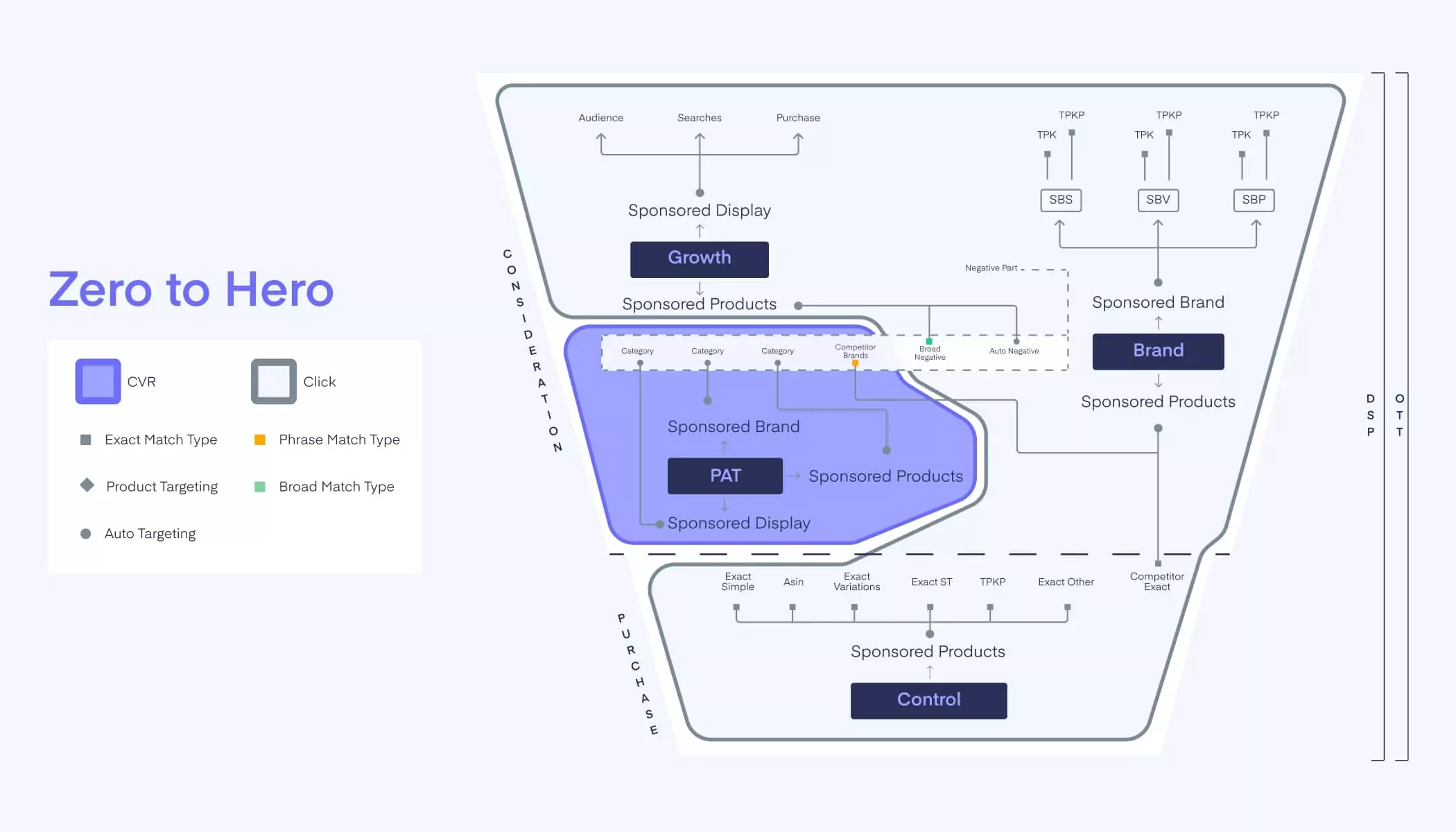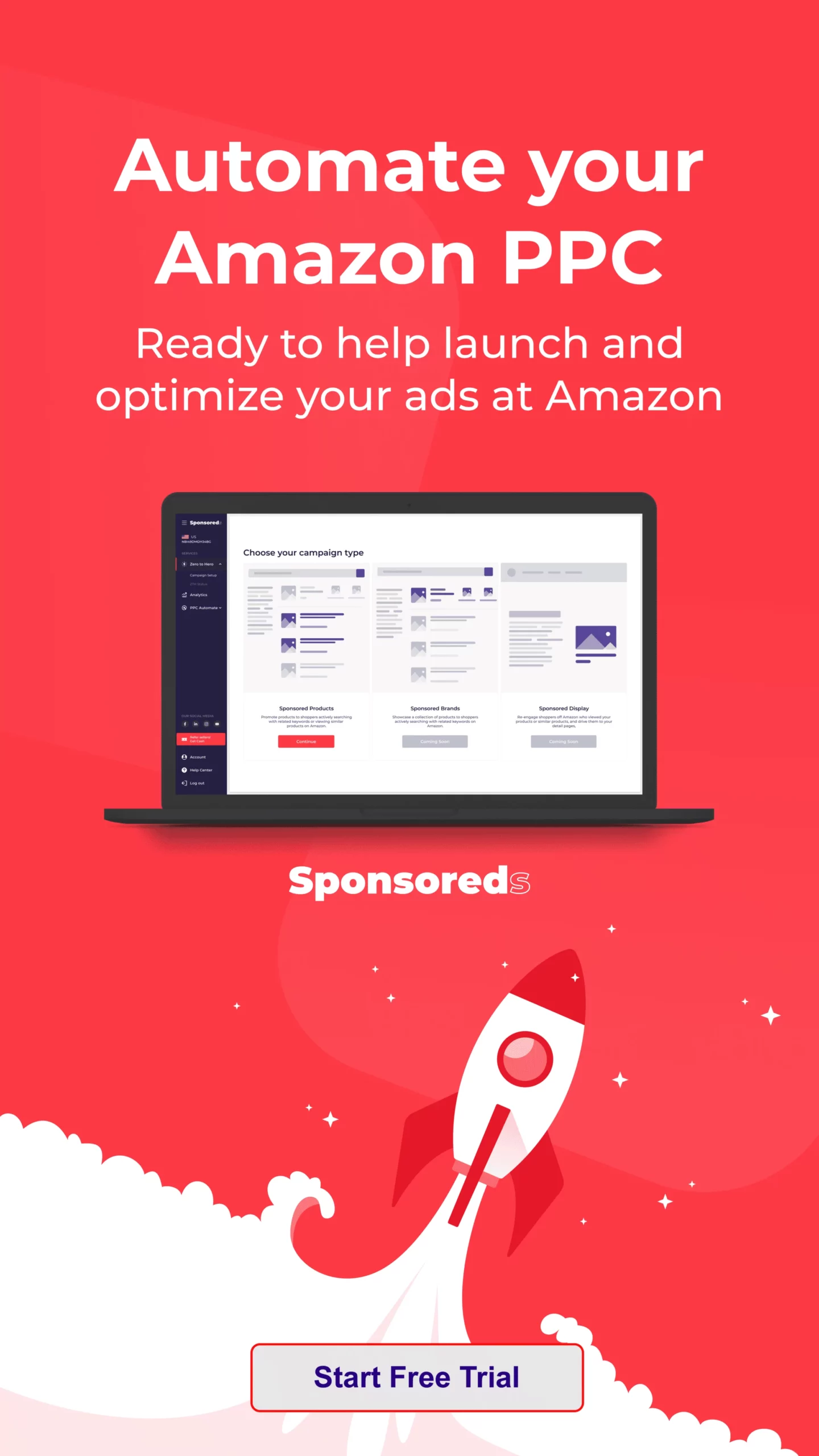Setting up a well-organized and effective Amazon PPC campaign structure is crucial for any business looking to thrive in the competitive landscape of Amazon’s marketplace. A solid PPC campaign structure enhances your ability to manage and optimize your ads and maximizes your return on investment (ROI). In this guide, we’ll explore the importance of a structured approach to Amazon PPC, discuss the key benefits, and provide a step-by-step guide on how to set up your campaign structure effectively with insights from Profit Whales.
Why You Need Amazon PPC Campaign Structure
Running an Amazon PPC campaign without a clear structure is like navigating a ship without a map. The Amazon advertising ecosystem offers a plethora of options, targeting methods, and bidding strategies that can easily overwhelm even the most experienced marketers. A well-defined Amazon PPC campaign structure serves as a roadmap, guiding your decisions and helping you stay focused on your goals.
The primary reasons you need a structured approach to your Amazon PPC campaign include:
- Clear Goal Definition: A structured PPC campaign allows you to set clear objectives for each ad, ensuring that every dollar spent is aligned with your overall business goals.
- Efficient Budget Management: By organizing your campaigns effectively, you can allocate your budget more efficiently, avoiding overspending on underperforming ads.
- Improved Ad Relevance: A good structure helps maintain the relevance of your ads to the user’s search intent, which can improve your Quality Score and ad placement.
- Better Analytics and Reporting: With a structured campaign, interpreting analytics becomes easier, allowing for more accurate adjustments and improvements over time.
Key Benefits of Optimized PPC Campaigns
An optimized PPC campaign structure offers numerous benefits that go beyond just improving your ad performance. Here’s how it can integrate with your broader marketing efforts and contribute to long-term success.
Integration with Other Marketing Efforts
A well-optimized PPC campaign doesn’t operate in isolation. It integrates seamlessly with your other marketing strategies, creating a unified and consistent customer journey. By aligning your Amazon PPC campaigns with your social media efforts, email marketing, and content strategies, you reinforce your brand message across multiple channels, which can lead to higher brand recognition and better conversion rates.
For example, suppose you’re running a seasonal promotion across your social media platforms. In that case, you can sync your PPC campaigns to highlight the same offers, ensuring a cohesive experience for your audience. This not only boosts the effectiveness of your PPC campaign but also amplifies the impact of your overall marketing strategy.
Amazon Campaign Structure Setup with Profit Whales
Setting up an Amazon PPC campaign structure with Profit Whales involves a detailed and strategic approach that ensures every aspect of your campaign is aligned with your business objectives. Here’s how Profit Whales structures Amazon PPC campaigns to drive growth, protect your brand, and maximize conversions.
Growth
The Growth phase of the Amazon PPC campaign structure is all about expanding your reach and attracting new customers. This is achieved through Sponsored Products and Sponsored Display campaigns designed to increase traffic and visibility.
- Sponsored Products: These campaigns are crucial for capturing a wide audience. At Profit Whales, we use strategies like Broad Negative and Auto Negative to manage keyword targeting effectively. This helps expand your reach by including broader keywords while filtering out irrelevant traffic. For example, we might add all keywords from exact campaigns to negative exact and broaden the targeting keywords to increase traffic and discover new search terms.
- Sponsored Display: Campaigns target audiences based on their previous behavior, such as searches or purchases. This allows you to reach potential customers who are more likely to convert. By integrating Sponsored Display into your Amazon PPC campaign structure, you can improve overall indexing and discover high-performing search terms that you might have missed.
Brand
The Brand phase focuses on building and protecting your brand’s presence on Amazon. This involves using Sponsored Products and Sponsored Brands campaigns strategically.
- Sponsored Brand: Within this segment, we focus on Top Performing Keywords (TPK) campaigns. These campaigns ensure that your ads appear consistently at the top of search results, which is critical when your listings are competitive. For instance, if your product has competitive pricing, high reviews, or better ratings than your competitors, the TPK campaign will help you dominate the top search positions.
- Sponsored Products: Sponsored Products campaigns, such as Competitor Exact and Competitor Brands, are designed to protect your brand by targeting keywords associated with your competitors. This strategy ensures that you capture traffic that might otherwise go to rival products.
Control
The Control phase is where the complexity of your Amazon PPC campaign structure increases. This phase involves detailed segmentation and management of your campaigns to maximize conversions.
Exact Simple
In the Exact Simple segment, we focus on high-frequency and mid-frequency keywords that are managed dynamically. These keywords are divided into clusters or managed together to control budgets and ad placements more effectively. For example, if you’re selling headphones, you might have separate campaigns for “iPhone headphones” and “Android headphones,” each with its own set of targeted keywords.
Exact Variations
The Exact Variations campaign is used when your product comes in different variations, such as size, color, or style. By aligning keywords with specific product variations, you ensure that customers find exactly what they want. For instance, if you’re selling a dress available in black, blue, and red, you would create separate campaigns for each color variation to match the customer’s search intent.
Exact Other
This campaign includes unique, low-frequency keywords that don’t fit into other segments. These keywords often consist of long-tail search terms that might generate low traffic volumes but can capture overlooked niche markets. For example, a keyword like “professional 3.0 USB car charger” might not fit into broader campaigns but could be highly relevant for a specific audience.
Search Term Exact
The Search Term Exact campaign focuses on keywords from the search terms report that have already generated sales. This allows you to capture additional high-performing keywords that might have been missed in the initial setup. For instance, if a search term has generated multiple sales, it’s added to this campaign to ensure continued optimization and performance.
PAT
The PAT (Product Attribute Targeting) phase includes Sponsored Displays, Sponsored Products, and Sponsored Brand campaigns. These are designed to either steal traffic from competitors or protect your brand’s position in the market.
- Sponsored Display: This type of advertising targets competitors directly and can be crucial for gaining market share in a crowded space. It’s especially effective for registered brands that want to increase visibility and capture more traffic.
- Sponsored Products: Sponsored Products ads are available to professional sellers, vendors, and agencies. They are essential for maintaining visibility in competitive categories and are a core component of any Amazon PPC campaign structure.
- Sponsored Brand: Sponsored Brand ads, like Sponsored Display, are crucial for brand protection and market dominance. They include product collection ads, store spotlight ads, and video ads, all of which can be tailored to your brand’s specific needs.
Search Term Report ASINs and How to Use Them
The Search Term Report is an invaluable tool for optimizing your Amazon PPC campaign structure. This report provides detailed insights into which ASINs (Amazon Standard Identification Numbers) perform well and which need adjustments. Here’s how to use the data effectively:
TPA (Top Performing ASINs)
Top Performing ASINs are those that have high sales volumes and low ACoS. These ASINs are your top performers and should be prioritized in your campaigns. For example, if a specific ASIN consistently generates high sales with a low ACoS, it should be included in your TPA campaign to maximize its visibility and performance.
PA (Performing ASINs)
Performing ASINs are those that generate a few sales with a good ACoS and conversion rate. These ASINs are solid performers and should be included in your campaigns to maintain steady sales growth. For instance, an ASIN that generates two or three sales per week with an acceptable ACoS would be classified as a Performing ASIN.
RA (Risk ASINs)
Risk ASINs are those you’re testing or that have shown potential but have to prove themselves. These ASINs are included in campaigns with lower bids to assess their performance. For example, if an ASIN has generated one sale, you might include it in a Risk ASIN campaign to gather more data and determine if it’s worth further investment.
SA (Suggested ASINs)
Suggested ASINs are those that Amazon recommends based on your existing campaigns and performance data. These ASINs should be carefully filtered and selected before being added to your campaigns, such as suggested ASINs with higher prices or fewer reviews than your products, to maximize your competitive advantage.
TCA (Top Competitor ASINs)
Top Competitor ASINs are those that belong to your main competitors. Targeting these ASINs can help you capture traffic that would otherwise go to your competitors. For example, if you want to capture the Best Seller badge, you would target the top ten competitors in your category with a competitive offer.
SP DA (Defense)
The SP DA (Sponsored Product Defense) campaign is designed to protect your brand by targeting your own ASINs. This prevents competitors from capturing your traffic and ensures that your products remain highly visible. For example, targeting your ASINs in a Defense campaign can prevent competitors from appearing in your ad space.
Automated vs. Manual Campaign Management
Managing an Amazon PPC campaign can be done either manually or through automation. Each approach has advantages and challenges, and the choice between them depends on your needs and resources.
Keyword Optimization Strategies
Whether you choose automated or manual management, keyword optimization is crucial. This involves continually refining your keyword list based on performance data, adjusting bids, and analyzing the competition. Automated tools can handle these tasks efficiently, but manual oversight ensures that your strategy remains aligned with your overall goals.
Long-term Strategy and Scalability
A successful Amazon PPC campaign isn’t just about achieving short-term results; it’s about creating a strategy that can scale with your business. This involves regularly revisiting and refining your campaign structure to adapt to market changes, product expansions, and evolving customer behaviors. For example, as your business grows, you might need to expand your campaigns to include new products or target new markets, ensuring that your PPC strategy remains effective.
Common Pitfalls and How to Avoid Them
Even the most experienced marketers can encounter challenges when managing PPC campaigns. Understanding these common pitfalls and how to avoid them is key to maintaining an effective Amazon PPC strategy.
Seasonal Campaign Adjustments
One of the most common mistakes is failing to adjust campaigns for seasonal changes. Whether it’s the holiday rush or a summer slump, adjusting your PPC campaign to align with seasonal trends can significantly affect performance. For example, during the holiday season, you might increase your budget and focus on high-performing keywords to capture more traffic and sales.
Takeaway Message
Understanding and implementing a well-structured Amazon PPC campaign is critical for any marketer looking to succeed on the platform. A strategic PPC campaign structure enhances brand awareness and transforms potential customers into loyal advocates. While setting up and maintaining these campaigns can be time-consuming, the rewards are well worth the effort.
If you need help with setting up your Amazon PPC campaign structure, our team at Profit Whales is ready to assist you. Contact us today to find the best solution for your business.
FAQ
What are the prerequisites for starting an Amazon PPC campaign?
Before starting an Amazon PPC campaign, it’s important to have a well-optimized product listing, a clear understanding of your target audience, and a defined budget. Additionally, you should be familiar with Amazon’s advertising policies and have a strategy in place for managing bids and keywords.
How can I measure the success of my Amazon PPC campaigns?
Success in PPC campaigns can be measured through several key metrics, including ACoS (Advertising Cost of Sales), ROAS (Return on Ad Spend), conversion rates, and overall sales volume. Monitoring these metrics regularly will help you assess the effectiveness of your campaign and make necessary adjustments.
Are PPC campaigns effective for launching new products on Amazon?
Yes, PPC campaigns are particularly effective for launching new products on Amazon. They help increase visibility and drive initial sales, which can boost organic rankings and long-term success.
What role does ACoS play in managing Amazon PPC campaigns?
ACoS (Advertising Cost of Sales) is a critical metric in managing Amazon PPC campaigns. It represents the percentage of sales spent on advertising and helps determine the profitability of your campaigns. Keeping ACoS low while maintaining high sales volumes is key to a successful PPC strategy.
How frequently should Amazon PPC campaigns be adjusted for optimal performance?
Amazon PPC campaigns should be adjusted regularly to ensure optimal performance. This includes monitoring keyword performance, adjusting bids, and refining targeting strategies. Regular adjustments help maintain the relevance and effectiveness of your campaigns, especially in response to market changes or seasonal trends.






